Certain seasons lend themselves to great nature and wildlife photo opportunities. The obvious are summer with its peak wildflowers, the rut season for elk, or salmon runs for brown bear, or early autumn for fall color.
Some subjects such as wading birds in Florida or most landscape locales and coastal settings in Oregon and Maine are good at any time of the year. Foxes can fall into the latter category as well, in places where they appear on a daily basis.
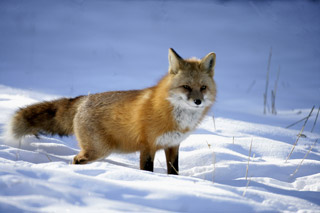
But, seasonality can play a role in great fox shots. One example happens when the young are first coming out of the dens and romping around. Another (especially for me) occurs during the winter months when the coats of the foxes are nice and thick and there’s snow on the ground for a wonderful contrast between their red coats and the white ground.
Two locations recently provided me with great fox opportunities. They can be found in the first nearly every day.
Prospect Park on the Wheat Ridge Greenbelt in the Denver metro area is well known as a fox haven. Over the years, as many as 25 to 30 foxes have called it home.
However, their numbers have decreased lately to about nine due to numerous coyote that have moved into the area and are slowly killing them off.
On a recent visit after a snow, I counted only five, including three that allowed some great photography and one (“Grumpy”) that didn’t want to play nicely with others. Over the years, many of the foxes at Prospect Park have been given names based on appearance, traits, or past fox lore.
Grumpy was given his name because of his affinity for not getting along with the other males in the area. (He was denned up with a female when I saw him, so he isn’t totally against mingling with other foxes.)
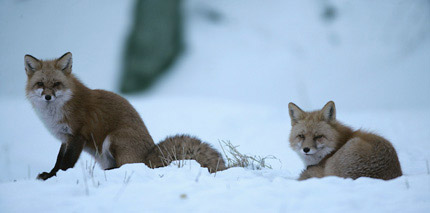
The reason the foxes are so easy to photograph in Prospect Park is that they’re used to having people in the area. Besides the constant flow of photographers, lots of people take their morning walks along the Greenbelt.
Although signs have been posted in recent years warning of penalties for feeding the foxes, numerous people who take daily walks offer morsels for these beautiful animals. Most offer good items such as dog bones, chicken parts, eggs, and other treats, but some toss out items not as healthy for their diet such as slices of bread.
I’m not encouraging taking treats to feed the foxes, but when you follow someone who does, your chances of great photos are improved.
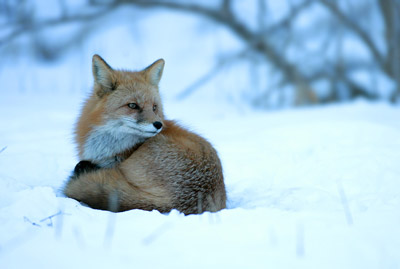
If you’re making your first visit to the park, ask people who are walking the path if and where they’ve seen a fox and then head that way. Go to one of the numerous areas where foxes have been spotted, set up, and wait for them to come out.
Morning is the best time to find them; during the winter months they can be spotted until as late as 10 a.m. You can also walk the numerous paths that cross the area to do your own spotting.
Note that lighting in a wooded area is not the best in some places, so you have to find subjects in an area where the light is good, live with the light you get, or use a flash.
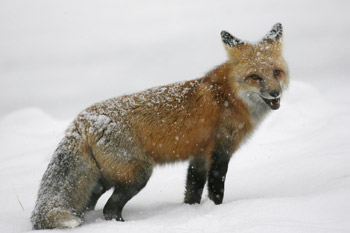
Most people who work the foxes use a lens such as a 100-400mm, because the foxes can come very close at times. Sometimes, they’ll walk within a couple of feet of you. While a 100-400 works nicely, there are times I’ll go out with my 600mm over my shoulder to set up a little farther away–in case they’re a bit skittish.
Although I no longer live in the Denver area, I count it a treat when I’m back there to stop in the park. I make a point of catching some fox shots, and I’m always glad I did.
The Wheat Ridge Greenbelt is designated a National Recreation Trail and is a total of 6.5 miles long. The area where the foxes are located is off 44th Avenue about a mile west of Kipling Boulevard. Drive to the parking area behind Prospect Lake, walk across the small bridge that spans Clear Creek, and head left or right as there are good spots for seeing the foxes in either direction.
The length of the area where the foxes are common is about a half mile long. In addition to the numerous foxes, there are lots of other photo opportunities to be found–primarily birds. With four lakes from which to choose, you can set up beside one to look for feathered subjects.
People have spotted nesting great horned and screech owls, hawks, and even eagles soaring overhead.
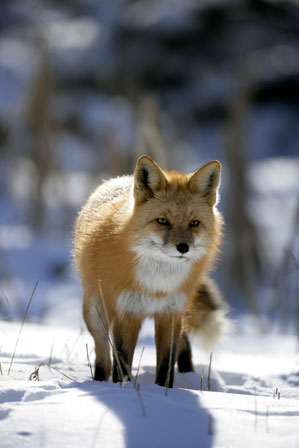
My second location for recent fox spotting was a lodge I’ve used for years for my bighorn sheep workshop. On the grounds of McGregor Mountain Lodge in Estes Park, CO, wildlife abounds. While in past years this has been a gathering spot for bighorn sheep in the rut, they weren’t that cooperative the last time I visited.
However, a bachelor herd of bull elk, some mule deer, and a selection of interesting birds around the feeders provided nice shooting for those on the workshop.
One day, a red fox came calling both in the morning and evening. He was quite cooperative and, during our evening session, he provided great poses with the snow accumulating all over his back.
The owners of the property said the fox has been showing up more often in the last year, giving lodge guests another reason to love the lodge and all that it offers by way of wildlife viewing.
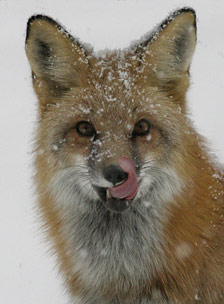
I always reserve the upper chalet rooms for photography workshops, as this is where a lot of the wildlife activity is. When we were heading out one morning, the fox just happened to be outside our doors, so we spent a bit of time taking shots until he decided to move on.
Our subject returned that night as we were coming in from our activity for the day. Due to low light conditions for both sessions, we bumped our ISO’s way up so that usable shutter speeds could get any images.
I was able to set up my 600 for a few shots at the end of the day. Since the fox frequently looked for tasty morsels on or around the bird feeders on the property, everyone was able to get great results. I can’t recommend traveling to the lodge expressly to capture the fox, however, since I’ve been going to Rocky Mountain National Park and Estes Park for 17 years, and that was the first time I came across a cooperative fox.
There are lots of places throughout the country where red fox roam. It you live near one or are visiting an area where they’re found, make a point of going to seek them out—especially if you have a chance to contrast their beautiful coats with snow.
by Andy Long

Hi Andy. My Name is Ron Green and I’m a retired wildlife photographer. I was wondering if you knew what the current status of the foxes are at Prospect Park or any of the other parks such as Fruitdale or Tomlinson? Are used to frequent Prospect back 2009 and 10 and got quite a few good images from there until the coyotes moved in And decimated the fox population. do you have any other suggestions for foxes? I live in the Springs. thank you for any suggestions you might have. Blessings.